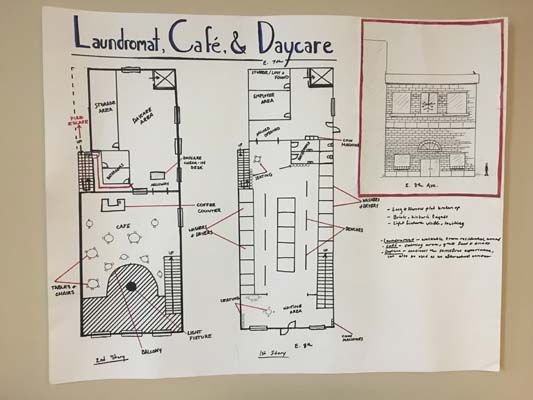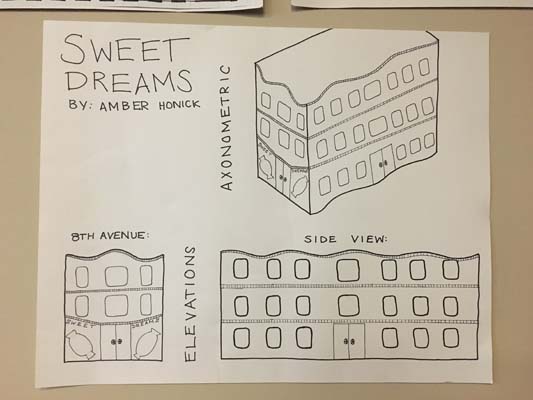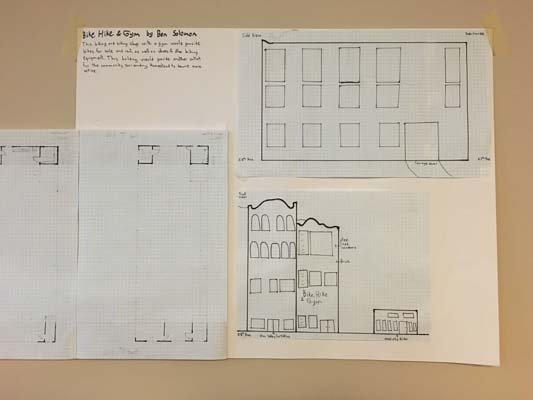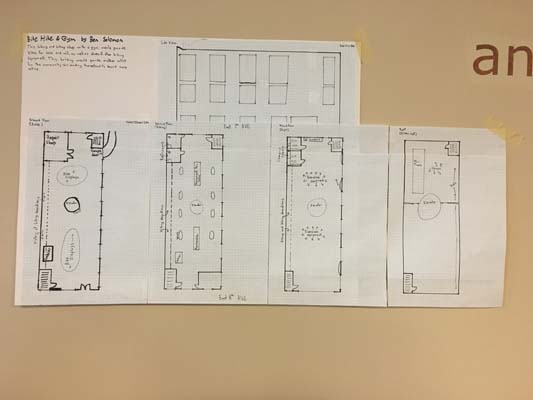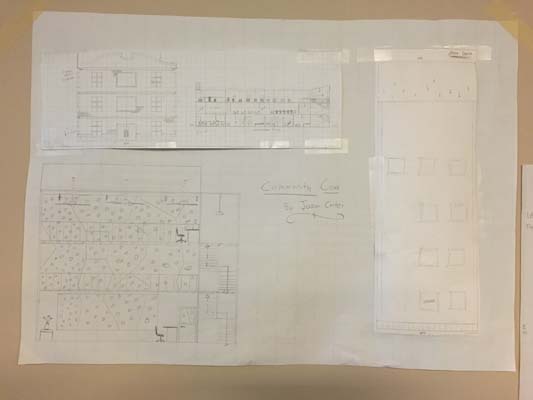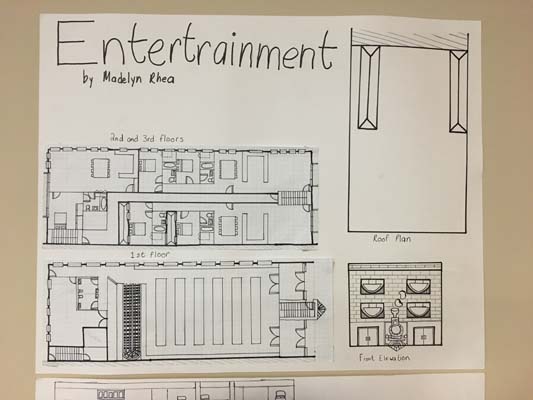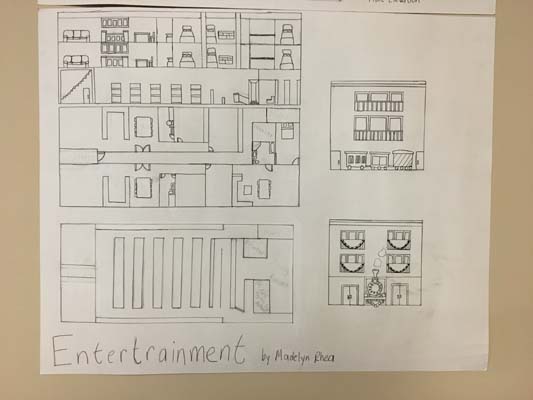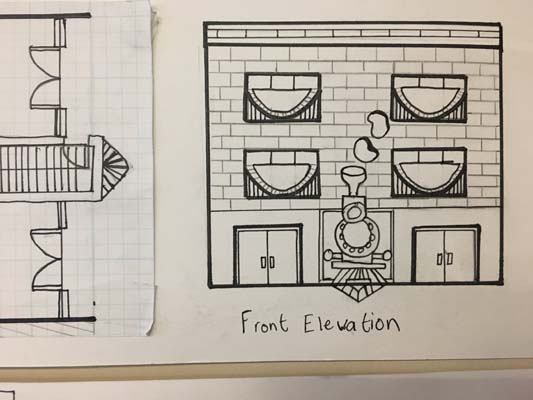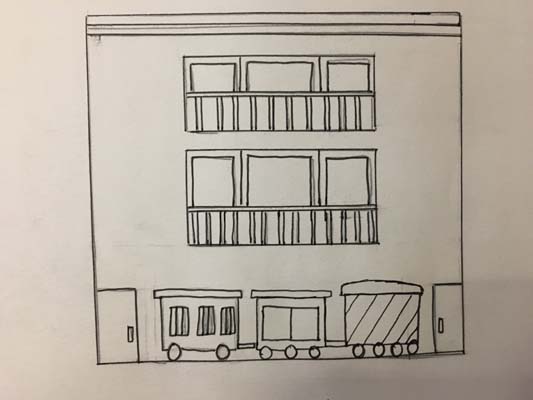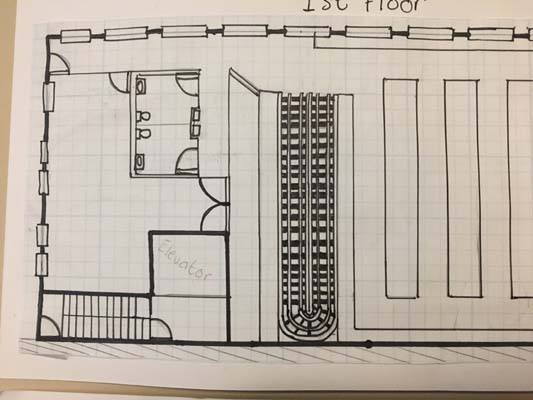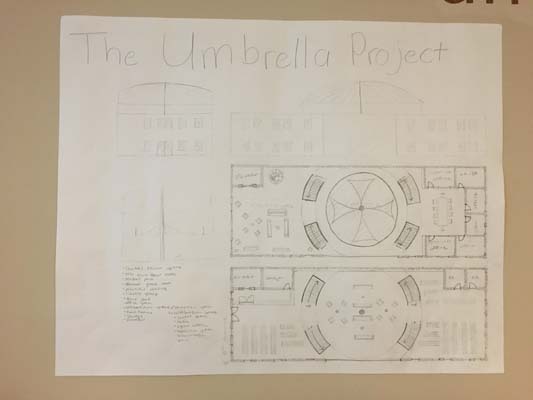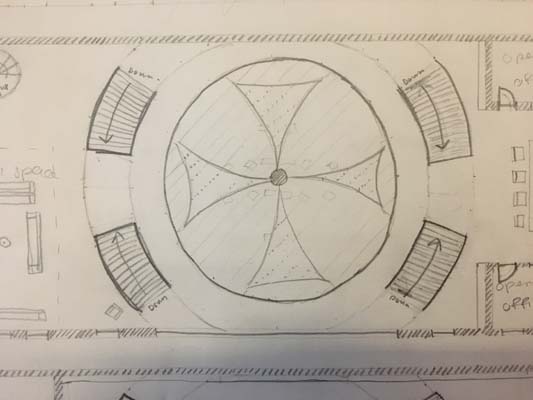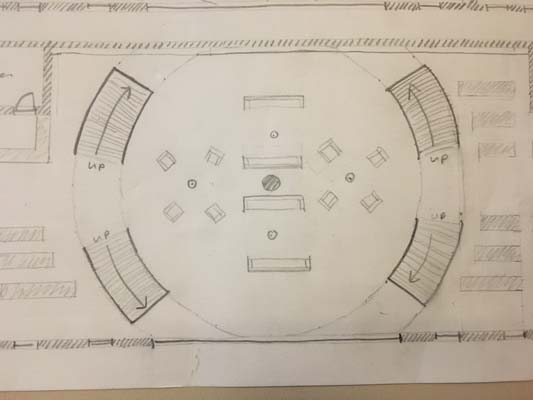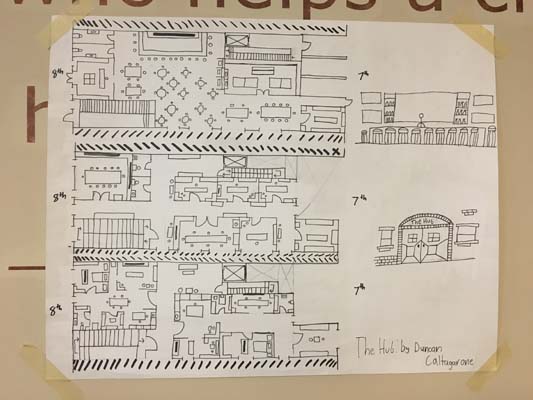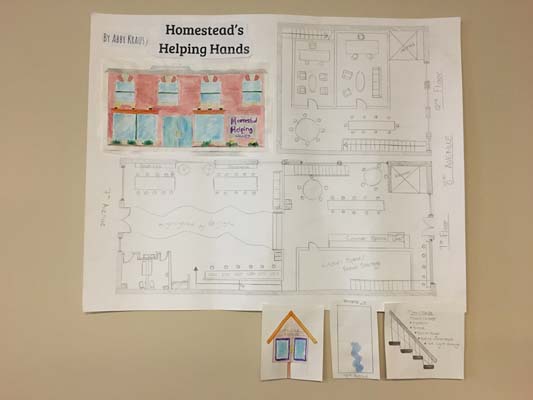
Latest News
-
High School Students Present Their Ideas for a Vacant Lot in Homestead
December 4, 2018 marked the fifth and final session of PHLF’s Architecture Apprenticeship program for high school students from various schools in Allegheny County. After touring the Carrie Furnace site and Bost Building, the students presented their designs for a vacant lot at 307-09 East Eighth Avenue in Homestead.
Kirsten Compitello of Michael Baker, Nicole Kubas of citySTUDIO, David Lewis, a distinguished urban designer and resident of West Homestead, Sarah Medwig of GAI Consultants, Patrick Shattuck of the Mon Valley Initiative, Jessica Stuck of PWWG, and Daniel Valentine, a developer in Homestead, critiqued the student projects and commended them for their concepts that would energize the main street and serve the community.
The students proposed developing the following mixed-use projects in the vacant lot at 307-09 East Eighth Avenue in Homestead:
- a laundromat with a café and daycare/after-school center;
- a candy store with apartments above;
- shops with biking and hiking equipment, a gym, and a green roof;
- a community meeting space, greenhouse, and rental space for offices;
- a community center with coffee and pastry shops, a library, martial arts studio, gym, and rock-climbing wall rising vertically through the three-story building;
- a toy store with apartments above;
- a collaborative community space and library with a green roof;
- a restaurant, office, and apartment building;
- a computer and counseling center with a deli, food bank, and library.
Their designs are shown in the gallery of photos below.
David Lewis reminded the apprentices that “buildings house human beings and human beings always house history and culture. The joy of being an architect is getting to those roots and giving them voice.”
When asked to describe their Architecture Apprenticeship experience in five short phrases, the students wrote:
- Eye-opening; informative; worth missing school for; more than I expected; fun, even if you want nothing to do with architecture.
- Immersive; valuable; educational/informative; decision-changing; perhaps the best opportunity I’ve had.
- Valuable; learned about Pittsburgh history; improved my drawing/presenting skills; educational; rewarding opportunity.
- Educational; enlightening; historical perspective; appreciate the city; walking tour.
- A great time; enjoyable; eye-opening; interesting; fun.
- Historical; kill two birds with one stone; informational; unexpected (in a good way); inspirational.
- Growth; problem solving; challenges.
- An experience (great!); educational; exciting; exposure; creative.
- Awe-inspiring; building connection; creating interest; experiencing design; learning about green and clean design.
- Historical perspective; professional exposure; walking tour; Chick-fil-A—David Lewis; conceptual (the “big picture”).
-
Grants from the McSwigan Family Foundation Fund of The Pittsburgh Foundation Support PHLF’s K-12 Education and Scholarship Programs

PHLF is one of the only organizations that offers year-round outdoor tour opportunities for schools. We believe in education through exploration and design tours in the real world that are connected to content the students are learning in the classroom. This helps make learning more relevant, meaningful, and memorable.
“The McSwigan Family Foundation Fund of The Pittsburgh Foundation recently approved two grants for PHLF: $5,000 in support of our Landmarks Scholarship Fund and $30,000 in support of our K-12 Education Programs,” announced PHLF Executive Director Louise Sturgess. “This is tremendous news and we are extremely grateful.”
PHLF’s education staff and docents will be able to continue a series of programs for thousands of students, including walking tours, architectural design challenges, and poetry and art workshops; expand certain programs to increase their impact on young people; and undertake several new initiatives, such as distributing Neighborhood Stories, Including Mine, produced by fourth-grade students from Pittsburgh Colfax, to many more school students in the new year.
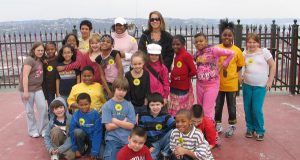 Since 1999, PHLF has helped 86 young people from Allegheny County pursue undergraduate degrees through its scholarship program. As the cost of higher education rises, the need for our scholarship program increases. More than 1,000 people have applied to our scholarship program during its 20-year history and, with increased funding support, we will be able to help more young people
Since 1999, PHLF has helped 86 young people from Allegheny County pursue undergraduate degrees through its scholarship program. As the cost of higher education rises, the need for our scholarship program increases. More than 1,000 people have applied to our scholarship program during its 20-year history and, with increased funding support, we will be able to help more young peopleWe have established wonderful relationships with many of our scholarship recipients and are proud that some have found jobs in Pittsburgh. For example, James Washabaugh (a 2004 recipient) has established Engine 30 Architecture in Pittsburgh. In addition, Kezia Ellison (a 2001 recipient) and Todd Wilson (a 2002 recipient) are both trustees of PHLF.
It turns out that this year two of our awardees who graduated from different Pittsburgh Public High Schools actually attended Pittsburgh Phillips as third-grade students and participated in our “Building Pride/Building Character” field trip. Chandler Searcy and Giovanna Varlotta are pictured in this photo from March 6, 2009 on the deck of the Duquesne Incline! It’s fair to say that PHLF played a part in developing their love for Pittsburgh.
Our K-12 Education Programs and Scholarship Program clearly have a positive impact on many thousands of young people. We are grateful to the donors who support them.
-
The Fine Foundation Awards Grant to PHLF
Thanks to funding support from The Fine Foundation, PHLF will be able to work with Manchester Academic Charter School teachers and students to create a permanent art display featuring Northside landmarks and local history for their new school that is scheduled to open in the spring of 2019 on the second-floor of the former Carnegie Library in Allegheny Center. In addition, SLB Radio will be able to install a “StoryBox” fixture so people can hear the voices of seven Northside celebrities whom the students interviewed in 2018.
This educational program helps fulfill the mission of The Fine Foundation by bringing together two focus areas within the Arts & Culture giving category––Art Education and the Visual Arts––and by making a positive difference in the lives of the MACS family. It builds on PHLF’s longtime involvement with the Northside community that began when the city was planning to demolish a row of historic houses on Liverpool Street (where MACS began and continues to have an elementary school).
Through “Our Northside Neighbors and Our New Middle School,” MACS students will develop more confidence in their artistic and writing abilities; be able to see the beauty of the built environment; develop a greater sense of belonging and feel part of the Northside story; and understand that historic places in their community can be inspirational sources for art and writing.
“We are grateful to The Fine Foundation for giving us the opportunity to work with MACS teachers and students in this creative project that builds pride of place and emphasizes the beauty and lasting community value of so many historic places on the Northside,” said Executive Director Louise Sturgess.
-
First-Ever “Architecture Day” in Oakland––Free For Architecture Enthusiasts of All Ages
Saturday, September 29, 201810:00 a.m. to 3:00 p.m. (stop by for any part of the day)Frick Fine Arts Building, University of Pittsburgh
650 Schenley Drive, Pittsburgh, PA 15260
Join Pittsburgh’s Architecture Learning Network (ALN) for the first ever “Architecture Day” on Saturday, Sept. 29 from 10:00 a.m. – 3:00 p.m. at the Frick Fine Arts Building. Learn about architecture educational programs throughout the Pittsburgh region for people of all ages; view architectural work on exhibit; and participate in discussions, workshops, and building tours.PHLF, an ALN partner, and other non-profit organizations will host free hands-on activities and exhibits in the first-floor gallery of the Frick Fine Arts Building and will offer a walking tour of the Oakland Civic Center (see below).
Architecture DayHosted by the Architecture Learning NetworkFrick Fine Arts Building, University of Pittsburgh650 Schenley Drive, Pittsburgh, PA 15260Saturday, September 29, 2018AGENDA10:00 a.m. – 3:00 p.m.Architecture Exhibit and Table Activities Hosted by ALN Partners––PHLF, UPitt, CMU, Fallingwater, YPA (morning), ACE, AIAS/Freedom By Design10:00 a.m. – 12:00 Noon- Panel Discussion, Where is Architecture in Pittsburgh?
- K-5 Grade Workshop, Fallingwater’s Gnome House Design Challenge
- K-5 Grade Workshop, Carnegie Mellon School of Architecture/UPitt, Building Up!
- PHLF Walking Tour, Oakland Civic Center (Advance reservations are required: marylu@phlf.org; 412-471-5808, ext. 527. Each tour is limited to 15 people.)
1:00 p.m. – 3:00 p.m.- Panel Discussion, How Sustainable is Pittsburgh?
- 6-12 Grade Workshop, Carnegie Mellon School of Architecture/UPitt, Analogue and Digital Media.
- 6-12 Grade Workshop, Fallingwater: Art of Design.
- PHLF Walking Tour, Oakland Civic Center. (Advance reservations are required: marylu@phlf.org; 412-471-5808, ext. 527. Each tour is limited to 15 people.)
Please come! -
“Right-Sizing” Is Not the Answer to the Challenges of Our Cities
By Arthur Ziegler
President, PHLF“We don’t know the future; Rust Belt Cities need to stop planning that there isn’t one.”
I recently saw this headline in an article on the web news magazine CityLab, and I was immediately reminded of what seems to me to be a misguided idea of people who are involved in urban planning, and even in historic preservation, that cities can be “right-sized.” Talk about a top-down strategy to excuse or as they often call it “manage decline.” What is the right size for Youngstown or Manhattan?
In the United States there are a series of major cities that are attracting young people, tech firms, advanced medical research, and lots of businesses providing jobs and a good quality of life. Has anyone done a study of what those cities share in common in the form of job creation, de-regulation, openness and diversity, public amenities, taxation, and what the Rust Belt cities share in common, and then look at the two groups for differences?
I have also noticed the trend where we have started calling rust belt cities “legacy cities,” and the primary subject does seem to be managing decline. We do have abundant evidence that retaining historic neighborhoods is one of the prime ingredients to attracting people into a city to live, to visit, and to hold on to the people who currently live there.
We preservationists should be arguing positively for appropriate changes in our cities that will make them attractive rather than giving up on large portions of our cities. Fortunately, the latter has been limited in Pittsburgh, but if you look at every neighborhood that has been subject to significant demolition and compared it to the historic neighborhoods where preservation was the fundamental ingredient in continuing to make our city attractive, you will see ample evidence that the “giving up” attitude of those who want demolition is harming the future of those cities.
In the CityLab article, Jason Hackworth of the University of Toronto, said that “this wave of destruction has not lead to market rebound or a decrease in social marginality. Those Rust Belt neighborhoods with the most disassembly since 1970 didn’t get better—they got worse.” Meanwhile, Alan Mallach, a scholar who was converted from the demolition approach, noted that “demolishing a lot of houses might be removing that neighborhood’s chance to survive in the future.” I certainly agree with him.
We preservationists should believe in the values of the architecture of our historic cities and encourage change and updating in other ways to compete nationally. Based on careful sensitivity to what is working elsewhere and to the great architectural treasures that we have can build new vibrancy. There is a bright future for rust belt cities, but we must begin with believing that to be true, and then we must have optimism and work towards utilizing the architectural legacy of these cities. Luckily Pittsburgh is doing that.
-
Audio-Recordings Describe People, Places, and Changes on the Northside

During a full-day program with PHLF on May 7, 2018, sixth-grade students from Manchester Academic Charter School explored several historic Northside places that have been adapted for new uses, and they also interviewed seven people who live and/or work on the Northside. SLB Radio recently produced audio-recordings based on those interviews.
Click here to listen to the stories of seven people who live and work on the Northside: Amber Farr, Director of One Northside, The Buhl Foundation; Bill and Kim Gandy, Curators, Allegheny City Historical Gallery; Faith Miller, Human Resources Coordinator, Children’s Museum of Pittsburgh; JuWanda Thurmond, Human Resources & Volunteer Coordinator, Children’s Museum of Pittsburgh; Karamagi Rujumba, Director of Development & Communications, PHLF; Mace Porac, PHLF docent; and Mark Fatla, Executive Director, Northside Leadership Conference.
Sixth-grade students from Manchester Academic Charter School interviewed these Northsiders during a special field trip and program PHLF planned for them on May 7, 2018, in cooperation with SLB Radio and the Children’s Museum of Pittsburgh. The students learned more about the history of the Northside and how it has changed over the years, in preparation for their move to their new middle school in the former Allegheny Regional Library in 2019.
PHLF thanks the McSwigan Family Foundation for supporting its educational programs that help young people explore their community, develop a sense of pride and belonging, and become active citizens.
-
Mt. Lebanon Design Guide Is Helpful to Homeowners Throughout the Region
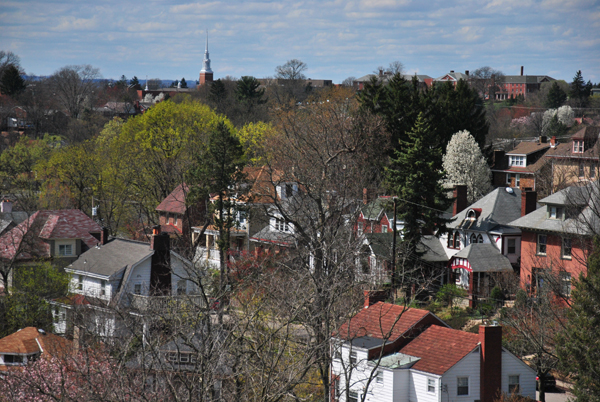
Mt. Lebanon, incorporated in 1912, includes a two-square-mile National Register Historic District that was listed in 2014. More than 4,000 properties constructed before 1945 are included in one of the best-preserved early-automobile suburbs in the nation. Photo courtesy of the Municipality of Mt. Lebanon.
Click here to see an on-line Design Guide developed for Mt. Lebanon’s National Register Historic District that is also a great resource for homeowners throughout the city. Many historic styles detailed in the Design Guide can be found in other Pittsburgh neighborhoods. The Design Guide provides overviews of historic and post-war architectural styles, as well as basic exterior home maintenance. The maintenance portion of the guide is organized by specific projects that homeowners might undertake, making the guide user-friendly and easy to refer to only applicable sections.
This guide expands upon voluntary guidelines developed in 2016 by T&B Planning at the request of residents of Virginia Manor, one of the neighborhoods in Mt. Lebanon’s National Register Historic District. Once those guidelines were completed, it became clear that the information would be helpful to residents throughout Mt. Lebanon who want to preserve and enhance their historic homes.
Nicole Kubas, an urban design consultant, created The Design Guide in collaboration with the Mt. Lebanon Historic Preservation Board and the Mt. Lebanon Public Information Office. Nicole also is a PHLF member who participates in many of our walking tours and assists with our middle and high school architectural design challenges and apprenticeship.
-
Calvary Episcopal Church Special Event Combines Public Tours, Art, Architecture, and Music
Sunday, October 7, 2018
- 4:00 PM: Docent-led tours begin
- 5:00 PM: Choral Evensong
- 6:00 PM: Chatham Baroque Performance
- 6:30 PM: Reception in Parish Hall

Calvary Episcopal Church at Shady Avenue and Walnut Street in Shadyside. Photo courtesy of Steel City Drones.
PHLF members and friends are invited to a free event on Sunday, October 7, from 4:00 to 7:00 p.m. at Calvary Episcopal Church, 315 Shady Avenue, Pittsburgh, PA 15206. The church, designed in 1905-07 by Boston architect Ralph Adams Cram, is listed on the National Register of Historic Places. The program will help participants appreciate how Cram wove his ideas of space, sound, and ceremony into his buildings. Reservations are not needed.
Cram’s architecture is well known in the Pittsburgh region. In addition to Calvary, he designed First Presbyterian Church (1913-19) in Greensburg; Holy Rosary Roman Catholic Church (1926-31) in Homewood; and East Liberty Presbyterian Church (1930-35). First Baptist Church (1909-12) in Oakland was designed by Cram’s firm and partner, Bertram Grosvenor Goodhue.
Calvary Episcopal Church will be open on Sunday, October 7 for docent-led tours between 4:00 and 5:00 p.m., followed by two brief musical performances: the Calvary Choir will present a service of Choral Evensong, and Chatham Baroque and Alan Lewis, Calvary’s Music Director, will present a brief concert to celebrate Calvary’s new harpsichord. The evening will conclude with a sherry reception in the Parish Hall.
This program is a unique opportunity to experience the way in which Ralph Adams Cram expressed his architectural ideas through music and liturgy. After seeing the architectural features of the church during the docent-led tours, guests will be able to reflect on these ideas while listening to the music of the Choral Evensong service. Choral Evensong––evening prayer in song––is heard in English Cathedrals and collegiate churches such as Cambridge and Oxford at the evening hour. The Calvary Choir is one of the foremost Episcopal church choirs in the country, regularly performing at Cathedrals and churches in Washington and New York.
The program is free and open to the public. The Reverend Jonathon Jensen is Rector of Calvary Episcopal Church and Dr. Alan Lewis is Director of Music.


